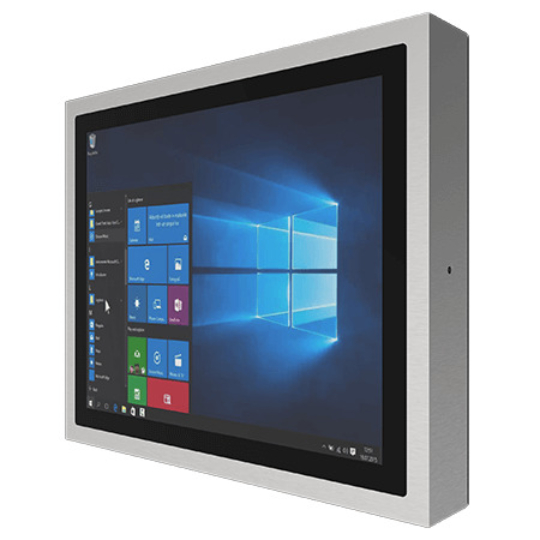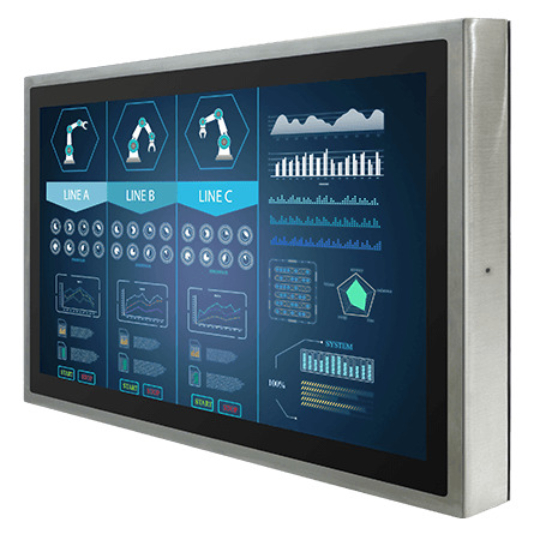Washdown Computer or Monitor Applications, Processes, and Solutions
Washdown computers and washdown monitors are installed in environments where they are exposed to water, dust, and other harsh corrosive materials. These environments include food processing plants, meat processing facilities, pharmaceutical factories, chemical plants, and other industrial settings where equipment needs to be regularly washed down and sanitised. Washdown computers are designed to be rugged in order to withstand the high-pressure water and chemicals used during cleaning processes, and they are built with specialized enclosures, sealed ports, and other features that help protect them from damage caused by exposure to moisture, dust, and other contaminants.
It is essential to select the proper level of ingress protection when choosing a washdown monitor or washdown computer for an area with steam, splash, spray, or water submersion. We will explain what needs to be considered for a computer to survive these washdown processes and help you pick a panel PC or industrial monitor with the appropriate level of ingress protection for the task to avoid failures in the field.
Furthermore, we will discuss different grades of stainless steel chosen in the manufacturing of a washdown solution which help prevent the corrosive effects of saline environments or washdown chemicals used to eliminate bacteria.
IP69K Washdown Computers and Washdown Monitors
What is a Washdown Computer or Washdown Monitor?
A most common type of washdown computer is an IP69K rated industrial computer designed to endure the rigors of the washdown process. IP69K is protection against close range, high-pressure, and high-temperature water jets typically used in wash-down environments. This process typically involves the use of high-pressure and high-temperature water jets to disinfect and clean industrial machinery and equipment. To withstand these harsh conditions, the washdown computer must be constructed from materials that are resistant to water, rust, and corrosion. Additionally, the components must be sealed to prevent water from entering and damaging the internal components. Furthermore, the overall design must be durable enough to resist physical damage from the pressurised water jets. This includes having a flat surface to reduce any potential crevices or recesses that could trap water and cause corrosion. Finally, the washdown computer must be easy to clean and disinfect, as any residue left behind could be a potential source of contamination.
Learn more about ingress protection ratings for waterproof computers.
The Washdown Process Used For Food Processing
At the end of a shift, food processing operations often require a thorough washdown procedure to ensure the removal of bacteria, microorganisms, and particles from areas near or in contact with consumable items or those with a tightly regulated chemical process. This process was designed to clean equipment with maximum safety.
Implementing a regular cleaning schedule ensures that the computer is cleaned and disinfected on a regular basis. Employees should be trained on proper cleaning procedures and make sure they understand the importance of keeping the washdown computer clean and free from bacteria.
The National Sanitation Foundation provides a summary of the washdown process which takes place at regular frequencies at food packaging facilities. These facilities have IP69K Panel PCs placed at various locations on the manufacturing line.
1. Remove Debris – Clear away any large pieces of matter, such as dirt, proteins, minerals, or lubricants, by using a cloth, mop, or broom.
2. Rinse Residue – It is necessary to start off by rinsing with warm water not exceeding 48.9°C/120°F in order to prevent the particles from sticking to a surface due to increased heat.
3. Apply Detergent – Creating a balanced blend of water and cleaning agents is necessary to ensure effective cleaning without causing too much damage. In some cases, a strong concentration of detergent and hot steam are needed to prepare a surface for sanitising with an alcohol-based solution, thereby allowing the equipment to dry quickly.
4. Rinse Detergent – It is critical to completely remove any soaps or cleaning products from the area before moving on. After taking out the dirt and dust, the temperature of the water can be higher than what it was during the first washing.
5. Inspection – A thorough examination of all equipment should be conducted, paying close attention to areas that may be harder to access and any cracks or crevices present. Efforts should be made to reduce the amount of cracks and crevices in all areas when choosing or installing a washdown computer.
6. Sanitise – Utilize an anti-microbial substance to terminate germs and other microorganisms.
7. Dry – The best way to dry a sanitised surface is to simply let the air do its work. If a high temperature spray or steam is used, the surface will still be warm and will be able to dry quickly in the air.
Choosing High Grade Stainless Steel with Anti-Corrosive Properties
It has been demonstrated that a computer designed for washdown use must be able to withstand the following environmental factors:
- Continuous Warm Water Flow
- Chemical Detergents and Sanitising Agents
- High-pressure Spray Using Hot Water
- Steam Cleaning
Testing has verified that, aside from chemical exposure, an IP69K computer or IP69K Monitor can endure all aspects of a washdown, such as being sprayed with intense jets from multiple angles for an extended period. To endure the cleansing agents, the computer or display housing is typically made of SUS304 or SUS316 stainless steel.
SUS316 steel offers more protection from chemical erosion than the more economical SUS304, making it the ideal choice for facilities where regular washdowns occur. The cost difference between SUS304 and SUS316 stainless steel should be weighed against the frequency of cleaning and what agents are used to decide which type of steel is best.
Learn more about the difference between SUS304 and SUS316 stainless steel in industrial computing.
Removing Points of Failure and Bacteria Build-up
Deploying hundreds of Panel PCs and Industrial Displays into environments where they must withstand harsh cleaning processes, we have gained an understanding of the features and elements that will best stand up to such treatments. Smaller details such as the inclusion of flat antenna covers, M12 circular connectors, and waterproof cables all play a major role in the computer’s longevity. Learn more about M12 circular connectors providing rugged and waterproof connectivity.
Aside from the stainless steel computer housing of a washdown computer, the touchscreen glass, any buttons or antennas, and I/O such as LAN or USB all need to be able endure the cleaning procedure as well as prevent bacteria build-up. Utilising a true flat front bezel design, specialized hygienic bolts for assembly, and simplified mounting methods all help in reducing contamination build-up which is harder or more time consuming to remove.
With decades of industry insight, Things Embedded has been utilising its expertise to provide these washdown computers or display solutions and is looking forward to continuing to provide new computer technologies to the manufacturing industry.
Looking For A Washdown PC or Washdown Display?
Tell us about your application and a member of our team will get right back to you.


